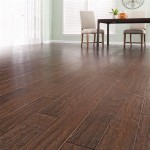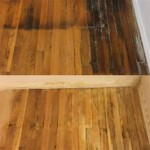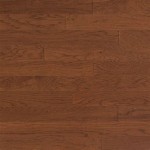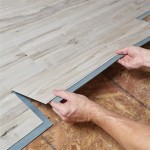Can You Install Laminate Flooring Over Linoleum? A Comprehensive Guide
The question of whether laminate flooring can be installed directly over existing linoleum is a common one for homeowners considering a floor renovation. While aesthetically appealing and relatively easy to install, laminate flooring requires a stable and even subfloor to perform optimally. Existing linoleum, depending on its condition and type, might serve as a suitable subfloor in certain circumstances. This article will explore the factors to consider when making this decision, outlining the potential benefits and drawbacks, and providing guidance on proper preparation techniques.
Laminate flooring is a multi-layer synthetic flooring product fused together through a lamination process. It simulates the appearance of wood, stone, or tile, providing a durable and cost-effective alternative to natural materials. Linoleum, on the other hand, is a flooring material made from renewable materials such as linseed oil, cork dust, wood flour, and rosin. It is known for its durability and natural antibacterial properties. Laying laminate flooring over linoleum can potentially save time and money by eliminating the need for demolition and disposal of the existing floor. However, careful evaluation and preparation are crucial to ensure a successful and long-lasting installation.
Key Considerations Before Installation
Several critical factors must be evaluated before proceeding with laminate flooring installation over linoleum. Failing to address these aspects can lead to problems such as unevenness, squeaking, moisture issues, and premature wear of the laminate floor.
Condition of the Linoleum: The existing linoleum must be in good condition to serve as a suitable subfloor. Any signs of damage, such as tears, cracks, curling edges, or excessive wear, indicate that the linoleum is not suitable for overlaying. These imperfections will telegraph through the laminate flooring, creating an uneven surface and potentially causing the laminate to fail. Furthermore, loose or damaged linoleum can trap moisture, leading to mold and mildew growth under the new floor. Thoroughly inspect the entire linoleum surface, paying close attention to seams, edges, and areas with heavy foot traffic. Address any minor repairs, such as gluing down loose edges, before proceeding. If the linoleum is extensively damaged, removal is the recommended course of action.
Adhesion of the Linoleum: The linoleum must be securely bonded to the subfloor. If the linoleum is loose or lifting in any areas, it will create movement under the laminate flooring, leading to instability and potential damage. Test the adhesion by attempting to lift the linoleum at various points in the room, especially in areas where it may be susceptible to moisture or heavy traffic. If the linoleum is not securely bonded, it must be either fully adhered or completely removed. Attempting to secure loose linoleum with adhesives can be a temporary fix, but it is not a long-term solution, as the underlying problem may persist. In cases of widespread adhesion issues, removal is generally the most reliable approach.
Levelness of the Surface: Laminate flooring requires a level and even subfloor for proper installation. Any dips or humps in the linoleum surface will be reflected in the finished laminate floor, creating an unsightly appearance and potentially causing joint separation or cracking. Use a long level or straightedge to check the floor's levelness in multiple directions. Any significant variations should be addressed before installing the laminate flooring. Self-leveling compounds can be used to fill in low spots and create a smooth, even surface. High spots can be sanded down if the linoleum material allows. Achieving a level subfloor is essential for the longevity and performance of the laminate flooring.
Preparation Steps for Installing Laminate Over Linoleum
Assuming the linoleum meets the criteria for a suitable subfloor, several preparation steps are necessary to ensure a successful laminate flooring installation. These steps will help to create a stable, clean, and moisture-resistant surface for the new flooring.
Cleaning and Repairing the Linoleum: The linoleum surface must be thoroughly cleaned to remove any dirt, dust, grease, or other contaminants. Use a mild detergent and water solution, followed by a clean water rinse. Allow the floor to dry completely before proceeding. Repair any minor imperfections, such as small cracks or chips, with a suitable patching compound designed for resilient flooring. Ensure the patching compound is fully cured and sanded smooth before continuing. Secure any loose edges or corners with appropriate adhesive, following the manufacturer's instructions.
Installing an Underlayment: An underlayment is a thin layer of material placed between the linoleum and the laminate flooring. It provides several benefits, including cushioning, sound insulation, and moisture protection. Choose an underlayment that is specifically designed for use with laminate flooring and that is compatible with the existing linoleum. Some underlayments have a built-in moisture barrier, which is particularly important if the linoleum is installed over a concrete slab. Install the underlayment according to the manufacturer's instructions, ensuring that it is properly aligned and secured to the linoleum surface. Overlapping seams should be taped to prevent moisture from seeping through.
Acclimation of the Laminate Flooring: Laminate flooring needs to acclimate to the room's temperature and humidity levels before installation. This process allows the planks to expand or contract, minimizing the risk of gapping or buckling after installation. Store the laminate flooring in the room where it will be installed for at least 48 to 72 hours before beginning the installation process. Follow the manufacturer's recommendations for acclimation procedures, as they may vary depending on the specific product.
Potential Problems and Solutions
Even with meticulous preparation, certain problems can arise when installing laminate flooring over linoleum. Understanding these potential issues and having solutions in mind can help to mitigate risks and ensure a successful outcome.
Moisture Issues: Moisture is a significant threat to laminate flooring. If the linoleum is installed over a concrete slab without a proper moisture barrier, or if there are leaks or humidity problems in the room, moisture can seep up through the linoleum and damage the laminate flooring. Symptoms of moisture damage include warping, swelling, and mold growth. Prevention is key. Ensure a proper moisture barrier is in place, and address any leaks or humidity issues before installing the laminate flooring. If moisture problems are suspected, consider using a moisture meter to check the moisture content of the linoleum and the subfloor. In severe cases, removing the linoleum and installing a new moisture barrier may be necessary.
Squeaking: Squeaking can occur if the laminate flooring is not properly installed, if the subfloor is uneven, or if there is movement between the laminate flooring and the linoleum. Identifying the source of the squeak is crucial for addressing the problem. If the squeaking is caused by an uneven subfloor, leveling the surface with self-leveling compound before installation can help. If the squeaking is caused by loose planks, re-securing them according to the manufacturer's instructions can resolve the issue. Lubricating the joints between the planks with a silicone-based lubricant can also help to reduce friction and eliminate squeaking.
Unevenness: As previously mentioned, unevenness in the linoleum subfloor will be reflected in the finished laminate floor. This can create an unsightly appearance and potentially damage the laminate flooring. Before installation, thoroughly inspect the linoleum surface for any dips or humps. Use a self-leveling compound to fill in low spots and create a smooth, even surface. Sand down any high spots if the linoleum material allows. If the unevenness is severe, removing the linoleum and installing a new subfloor may be the best option.

How To Install Luxury Vinyl Tile Over Linoleum Your Home Renewed

Installing New Flooring Over Linoleum Let S Talk

Can You Lay Tile Over Linoleum Rubi Blog Usa

Handy How To Guide For Installing L Stick Tile Over Linoleum

Diy How To Install Should You Laminate Over Carpet

How To Install Floating Vinyl Flooring Over Old Floors Simply2moms

Handy How To Guide For Installing L Stick Tile Over Linoleum

Should You Install Vinyl Floor Over Tile

Can I Overlay Vinyl Flooring Over Parquet Singapore

Installing Luxury Vinyl Floors Over Engineered Hardwood Honey Built Home
Related Posts








